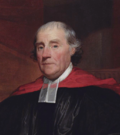The following is a list of the presidents of the University of Pennsylvania, which began operating in 1751 as a secondary school, the Academy of Philadelphia, and added an institution of higher learning in 1755, the College of Philadelphia .
| No. | Image | Provost [note 1] | Years as provost | Name of institution | Refs. |
|---|---|---|---|---|---|
| Leaders of predecessor non-collegiate schools 1740–1754 | |||||
| – |  | The Reverend George Whitefield [note 2] | 1740–1749 | Unnamed Charity School [note 3] | |
| – |  | Benjamin Franklin [note 4] | 1749–1754 | Academy of Philadelphia | |
The following persons had led the University from 1754 to 1930 as provost: [1]
| No. | Image | Provost | Term start | Term end | Refs. |
|---|---|---|---|---|---|
| Provost of the College of Philadelphia (1754–1779) | |||||
| 1 |  | The Reverend William Smith [note 5] | 1754 | 1779 | [2] |
| Provosts of the University of Pennsylvania (1779–1930) | |||||
| 2 |  | The Reverend John Ewing [note 5] | 1779 | 1802 | [3] |
| Position vacant 1802–1806 [1] | |||||
| 3 | The Reverend John McDowell | 1807 | 1810 | [4] | |
| 4 |  | The Reverend John Andrews | 1810 | 1813 | [5] |
| 5 | The Reverend Frederick Beasley | 1813 | 1828 | [6] | |
| 6 |  | The Right Reverend William Heathcote DeLancey | 1828 | 1834 | [7] |
| 7 | The Reverend John Ludlow | 1834 | 1852 | [8] | |
| 8 |  | The Reverend Henry Vethake | 1853 | 1859 | [9] |
| 9 |  | The Reverend Daniel Raynes Goodwin | September 1860 | June 1868 | [10] [11] |
| 10 |  | Charles Janeway Stillé | September 30, 1868 | June 15, 1880 | [12] [13] [14] [15] |
| 11 |  | William Pepper | February 22, 1881 | June 5, 1894 | [16] [17] [18] [19] |
| acting |  | Charles Custis Harrison | June 6, 1894 | June 3, 1895 | [20] |
| 12 | June 3, 1895 | December 31, 1910 | [21] [22] [23] | ||
| 13 |  | Edgar Fahs Smith | January 1, 1910 | June 30, 1920 | [24] [25] [23] [26] |
| Interim | Josiah Harmar Penniman | July 1, 1920 | January 15, 1923 | [27] [26] | |
| 14 | January 15, 1923 | June 30, 1930 [note 6] | [27] [28] [29] | ||
The following persons had led the University since 1930 as president: [30]
| No. | Image | President | Term start | Term end | Refs. |
|---|---|---|---|---|---|
| 1 |  | Thomas Sovereign Gates | July 1, 1930 | June 30, 1944 | [31] [29] |
| 2 |  | George William McClelland | June 30, 1944 | September 19, 1948 | [32] [33] |
| 3 |  | Harold Stassen | September 20, 1948 | January 20, 1953 [note 7] | [34] [35] [36] |
| Acting |  | William Hagan DuBarry | January 21, 1953 | May 24, 1953 | [36] |
| 4 |  | Gaylord Probasco Harnwell | May 25, 1953 | August 31, 1970 | [37] [38] [39] |
| 5 |  | Martin Meyerson | September 1, 1970 | January 31, 1981 | [40] |
| 6 |  | Sheldon Hackney | February 1, 1981 | June 30, 1993 | [41] |
| Interim | | Claire Fagin | July 1, 1993 | June 30, 1994 | [42] |
| 7 |  | Judith Rodin | July 1, 1994 | June 30, 2004 | [43] [44] |
| 8 |  | Amy Gutmann | July 1, 2004 | February 8, 2022 [note 8] | [45] [46] |
| Interim |  | Wendell Pritchett | February 9, 2022 | June 30, 2022 | [47] |
| 9 |  | M. Elizabeth Magill [note 9] | July 1, 2022 | December 9, 2023 [note 10] | [48] [49] [50] |
| Interim |  | J. Larry Jameson | December 12, 2023 | March 13, 2025 | [51] |
| 10 | March 13, 2025 | Present | [52] |

